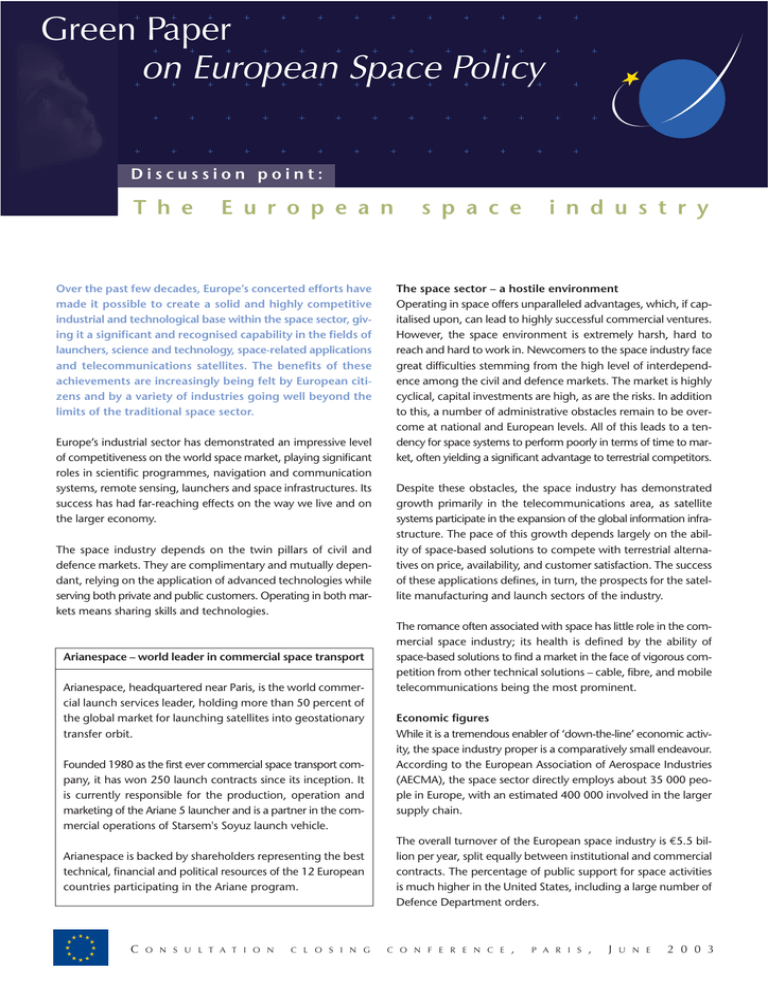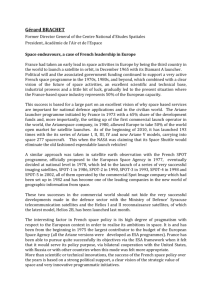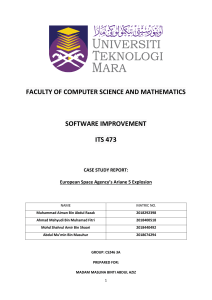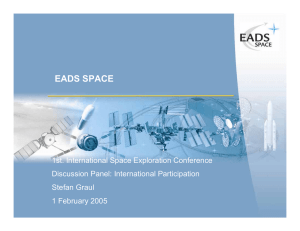Green Paper on European Space Policy
advertisement

Green Paper on European Space Policy Discussion point: T h e E u r o p e a n Over the past few decades, Europe’s concerted efforts have made it possible to create a solid and highly competitive industrial and technological base within the space sector, giving it a significant and recognised capability in the fields of launchers, science and technology, space-related applications and telecommunications satellites. The benefits of these achievements are increasingly being felt by European citizens and by a variety of industries going well beyond the limits of the traditional space sector. Europe’s industrial sector has demonstrated an impressive level of competitiveness on the world space market, playing significant roles in scientific programmes, navigation and communication systems, remote sensing, launchers and space infrastructures. Its success has had far-reaching effects on the way we live and on the larger economy. The space industry depends on the twin pillars of civil and defence markets. They are complimentary and mutually dependant, relying on the application of advanced technologies while serving both private and public customers. Operating in both markets means sharing skills and technologies. Arianespace – world leader in commercial space transport Arianespace, headquartered near Paris, is the world commercial launch services leader, holding more than 50 percent of the global market for launching satellites into geostationary transfer orbit. Founded 1980 as the first ever commercial space transport company, it has won 250 launch contracts since its inception. It is currently responsible for the production, operation and marketing of the Ariane 5 launcher and is a partner in the commercial operations of Starsem's Soyuz launch vehicle. Arianespace is backed by shareholders representing the best technical, financial and political resources of the 12 European countries participating in the Ariane program. C European O N S U L T A T I O N C L O S I N G s p a c e i n d u s t r y The space sector – a hostile environment Operating in space offers unparalleled advantages, which, if capitalised upon, can lead to highly successful commercial ventures. However, the space environment is extremely harsh, hard to reach and hard to work in. Newcomers to the space industry face great difficulties stemming from the high level of interdependence among the civil and defence markets. The market is highly cyclical, capital investments are high, as are the risks. In addition to this, a number of administrative obstacles remain to be overcome at national and European levels. All of this leads to a tendency for space systems to perform poorly in terms of time to market, often yielding a significant advantage to terrestrial competitors. Despite these obstacles, the space industry has demonstrated growth primarily in the telecommunications area, as satellite systems participate in the expansion of the global information infrastructure. The pace of this growth depends largely on the ability of space-based solutions to compete with terrestrial alternatives on price, availability, and customer satisfaction. The success of these applications defines, in turn, the prospects for the satellite manufacturing and launch sectors of the industry. The romance often associated with space has little role in the commercial space industry; its health is defined by the ability of space-based solutions to find a market in the face of vigorous competition from other technical solutions – cable, fibre, and mobile telecommunications being the most prominent. Economic figures While it is a tremendous enabler of ‘down-the-line’ economic activity, the space industry proper is a comparatively small endeavour. According to the European Association of Aerospace Industries (AECMA), the space sector directly employs about 35 000 people in Europe, with an estimated 400 000 involved in the larger supply chain. The overall turnover of the European space industry is €5.5 billion per year, split equally between institutional and commercial contracts. The percentage of public support for space activities is much higher in the United States, including a large number of Defence Department orders. C O N F E R E N C E , P A R I S , J U N E 2 0 0 3 Public support for space? Speaking at the Space Green Paper inauguration in Brussels, Alain Gaubert, Secretary General of Eurospace, stated, “I am not saying we want government help for the space industry. What I am saying is that government needs space and can be an important space customer and this is what will help the space industry.” A changing industrial landscape Space is a strategic ‘pioneer’ market involving extreme technical and financial risks, and very high costs for new players, justifying the major role played by public authorities. In this context, the optimum allocation of resources, the maintenance of transparency and reduced costs all play a part in ensuring competitiveness. Trends towards consolidation in the space sector are not to be excluded, particularly in Europe. The course currently being undertaken has been largely determined by the will of public authorities as expressed through the European Space Agency (ESA) industrial policy. EADS – a case in point The expense and risks inherent in space technology have encouraged widespread partnering at the national and commercial levels, and have led to significant consolidations in the European industrial sector. These consolidations and partnering arrangements include the creation and expansion of the European Aeronautic Defence and Space Company (EADS), now a world-scale competitor to the American leaders, Boeing and Lockheed-Martin. Economic benefits beyond the space industry Space technologies offer countless possibilities in terms of practical ground-based applications. As such, they represent increasing opportunities for players other than those within the traditional space industry, including small- and medium-sized enterprises, service providers, content providers and private and public users. Space is a crucial link in the competitive knowledgebased society. Digital television, third generation mobile communications and the Internet are good examples of service platforms to which space-systems contribute. At this critical juncture, therefore, priority must be given to the ongoing process of transferring space technologies from the research sector to the commercial sector. It is equally essential to support research aimed at industrial applications and value added services that go beyond the strict context of space. Maintaining technological excellence In order to remain competitive, the European space industry, as well as all the industries it feeds, needs to maintain a full range of research and demonstration programmes to support a broad and efficient technological base. This means early identification of future technological requirements and close co-operation among the space industry, service providers and public research institutes. The European Union, the ESA and national players have all established instruments for providing support throughout the value chain. As the EADS trans-European consolidation continues to mature, the emphasis has been largely on creating effective working relationships across the Franco-German cultural divide. The group is now moving towards increasing management efficiencies and finding synergies across the various divisions of the firm. C European O N S U L T A T I O N C L O S I N G C O N F E R E N C E , P A R I S , J U N E 2 0 0 3






